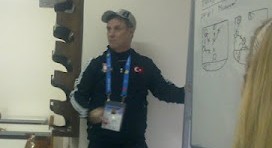The program contains lectures, teaching notes & videos.
This program allows us to share material and ideas with you.
Please send email to Keith.f.McAdams@gmail.com for access to this presentation.
Relate Videos & Teaching Points:

The program contains lectures, teaching notes & videos.
This program allows us to share material and ideas with you.
Please send email to Keith.f.McAdams@gmail.com for access to this presentation.
Relate Videos & Teaching Points:
The Four T’s of Passing are key to developing fundamental sound players.
The best players maintain good technique at all times. Good technique must be emphasized on every pass.
The passer must choose the right type of pass. The player must choose when to use touch passes, first and second touch skating and passing. Players must choose when to make short or long pass. Players must choose when to pass to stick, space or use no space play. Players need to know when to use the boards to make a pass or clear.
Types of Passes
Each player must be “thinking off the puck” and working on being in position to receive a pass. Players need to work on things like: Am I calling for the puck when open? Can I see the puck? Am I in the best place for a pass? How can I give my teammate an option? Can I create space for others? The best players are always thinking and executing “OFF the Puck”.
The 4th “T” is for timing. Both the player with the puck and without the puck need to work on timing skills. Timing is everything in hockey. Arrive a little to fast, a little to slow and the play results in a turnover. The player with the puck must choose the right pace of the pass. Pass to hard it arrives to fast. Pass to slow, it behind the receiver or the puck is intercepted.
Related Videos & Teaching Points:
Power Thoughts:
A winner never whines.
-Paul Brown
Video Technology allows you to provide accurate feedback to your players. We use Facebook to give players instant feedback on their performance. We post videos daily to aid in the teaching process. We use videos to highlight good plays and motivate the players. If used right, video technology can be used to facilitate mental training and psychological skills necessary to win. Equipment Needed:
The simplest way to breakdown game videos is a followed:
Offensive Rush:
Offensive Control:
Forechecking:
Power Play:
Penalty Killing:
Face Offs:
Scoring Chance Form:
Period: Time Stamp: Team: Type: Description
1 1.23.01 ERZ OC 1st line cross, cycle shot & rebound
1 1.40.23 ERZ R Fatih driving wide, pulled down, leads to PP
1 2.10.06 ERZ PP FO/OC/Goal, Point shot, screen tip & rebound
You should record scoring chances from both teams. Keeping track of scoring chances, provides an accurate view of your teams strengths and weaknesses.
Power Thoughts:
“I believe God gave us crises for some reason—and it certainly wasn’t for us to say that everything about them is bad. A crisis can be a momentous time for a team to grow—if a leader handles it properly.” -Mike Krzyzewski
Every coach should have a coaching syllabus. For youth hockey I recommend you break it down into four areas. Every skill, system and tactic you will teach should be in the syllabus. Your syllabus must be detailed. Your syllabus should be re-worked and improved each year.
1. Skill syllabus
2. Defensive syllabus
3. Offensive syllabus
4. Special team syllabus
Your Coaching Syllabus Should Change Time to Time:
My syllabus includes the following:
System: Is the plan
Tactics: Is how you execute the plan
Principle: A rule used to choose among solutions to a problem which works most of the time.
Goals: Each practice, drills and concept must have measurable objectives
Reads: What players should see
Skills: List of skills and progressions
Keys: Smaller details
Rules: Things that Happen a lot
Roles: Responsibilities of Each player
Terms: “Good Vision Leads to Good Decisions”
Related Videos & Posts:
This is a copy of my philosophy on practice planning for my 14 and under club. My program is based on 11 ingredients:
1. Structure, Structure, Structure:
A successful practice has to be well planned and organized, following a clear set of objectives from start to finish.
2. Simple Warm-up On-Ice Stressing 1 or 2 Passing Drills:
3. Fundamentals & Defense:
4) Game Preparation:
5. Predictable & Variety:
6. Competition:
7. Accountability:
8. Winning & Improving Is Fun:
Don’t take yourself too seriously. Make sure your players are having fun or they’ll lose their drive and focus for training.
9. We focus on drill that stress the following:
10. Utilize Small Area Ice Drill:
The younger the group, the more time I would spend on small ice drills.
11. End With Small Games
Work on basic game principles including; Pressure, Possession, Defense, Passing, Movement, Shooting & Rebounding! Set the game up to target an area of your performance.
Power Thoughts:
“Repetition of the same thought or physical action develops into a habit which, repeated frequently enough, becomes an automatic reflex.”
-Norman Vincent Peale
Related Videos & Teaching Points:
Playing Rules:
Related Videos:
Playing Rules: Always Play Man You Goal in all Three Zones.